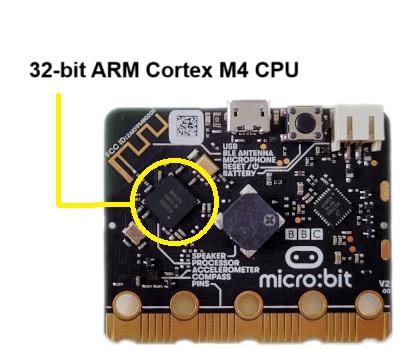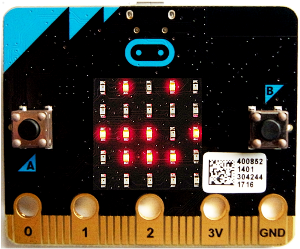Revised: November 2023
A micro:bit is an programmable microcontroller board. Like any computer, it has a processor, memory and an interface for input and output that you can control. Micro:bit is based on an ARM (Advanced RISC Machines) processor which belongs to the same family of CPU’s used on your Android phone.


It is equipped with 16KB RAM memory, eight times more than what was used to bring man to the moon and back using the Apollo’s Guidance Computer and 256 KB of flash memory to store and retain data when the device is powered off.
Update: version 2.0 has 128KB RAM and 512KB flash memory.
What differentiates micro:bit from other similar competing micro-controllers is how it was designed to have built-in 5 x 5 array of light emitting diodes (LEDs) that can each be set on or off. You can draw patterns like smiley face or emojis and even scroll a text message across the display. The brightness of the LEDs as a whole can also be controlled. It also contains two programmable button switches. The built-in LEDs and switches bring instant output feedback and on the spot input control when used by your programs without entailing additional cost. These built-in features lowers the barrier to entry and makes the micro:bit the most economic educational computer programming device for young students.

The on-board accelerometer and compass sensor brings additional functionality and programmability of the device. The bluetooth adds wireless communications capability. For additional input/output, the bottom of device has edge connectors or commonly called general purpose input and output (GPIO), designed for both easy access and connection using crocodile clips on the large pads or for precise control by using a breakout board. A reset button is present to start your code over from the beginning.

Update: version 2.0 has now built-in speaker, microphone, power LED indicator, touch sensor and a power off feature (push and hold power button). Bluetooth also has been upgraded to v5.0 from v4.0. The edge connector has added notch for easier connection.
To power the micro:bit, a JST connector is included to make it mobile and is powered by two AAA batteries. You could also power it up by hooking it thru your computer via the micro USB. This also serves as a way to download your program to the device. Finally, you can supply power thru the pads located at the bottom but be very careful when you do this and stay within the power design parameters of the device so that you don’t cause any damage t to it.
